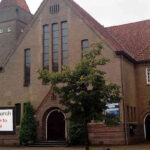It is fair to say that most churches today are built around performers and audience (although most wouldn’t see it that way).
It might be the preacher preaching while everyone sits in rows listening (or not!), the worship band playing or the priest leading the liturgy or the mass. But while the congregation is encouraged to participate, many remain passive consumers.
It’s easy to point to the problems with this, but more difficult to come up with better ways to do things. That’s why I always enjoyed the Church in a Circle blog.
Why participation is important
It all comes back to the human brain. We can only take in so much at a time, before the information overloads our short term memory. Sitting and listening is a very poor way to take in information, and isn’t likely to lead to transformation.
Learning, growing, being transformed require involvement, active participation, opportunities to reflect back what is learnt and to put it into practice. Normal performer-audience church doesn’t do this very well.
Active learning isn’t easy
One-on-one learning, for example via mentoring or apprenticing, is much more likely to involve the learner. But as the number of people being taught or discipled grows, it gets harder to keep them all involved.
Teachers should be trained to provide active learning situations, but ministers are less likely to have learned this – my guess is that they are mostly simply taught how to make sermons a little more interesting.
Church in a Circle blog
For these reasons, back almost a decade ago, one of my favourite blogs was Church in a Circle, in which Kath reflected on how she and her husband (and presumably others) used active learning techniques in a small church they were part of.
The byline of the blog was: “From monologue to dialogue. From audience to participants. From performance to empowerment.”
The authors say:
Church in a circle starts with the seating arrangement, but ultimately changes the way we meet and interact as God’s people. It changes us from consumers into participants. It changes the way we see each other. It changes the way we learn and teach others about God. It’s time to stop filling rows and start forming circles.”
Gems from the blog
These were some of the ideas I appreciated there:
- Doing things what seems to be the easiest way (for the ministers at least) ends up achieving the least.
- One leader, many teachers, no professors.
- Stop performing, start empowering.
- Get people talking – unlock them early.
- Discovery is the best teacher.
- Flip the classroom, flip the church.
- Stop bringing people to church, and start sending God’s church to the people.
- Perhaps we need to rethink our spaces, rearrange our seating, and redesign our buildings to reflect the purpose and function of gathering together as a church community.
- When people are participating and using their voice, they become engaged. They take ownership of their learning. They find their gifts and use them. They minister to one another.
Death and resurrection
Unfortunately, some years ago the blog was hacked and taken down. And Kath (I guess) was too busy raising a family and doing ministry to try to recover it all. But I discovered it could be found on The Wayback Machine.
So with Kath’s permission I have copied some of my favourite posts over to this site, and you can find them at Church in a Circle. (Innovative title, I know! 🙂 )
Check it out. Some of it is revolutionary and all of it is helpful. And as I have time, there’ll be more gems.




Thank you so much for doing this, Church in a Circle was one of my favourite blogs as well.
I’m glad. Thanks for telling me.